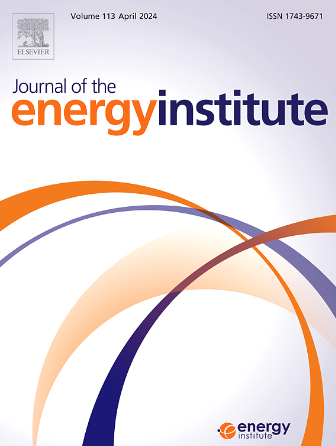研究老化对塑料热解的影响以及与褐煤共同热解的协同机制
IF 5.6
2区 工程技术
Q2 ENERGY & FUELS
引用次数: 0
摘要
废塑料与低阶煤的共热解探索了光老化如何影响塑料的热解,并深入研究了共热解过程中的协同机制。元素分析、X 射线粉末衍射和傅立叶变换红外光谱分析结果表明,光老化主要涉及氧化和断裂聚乙烯(PE)中的脂肪族链,以及生成羟基(-OH)、羰基(-C=O)和醚基(-C-O)等含氧官能团,从而降低聚乙烯的结晶度。单个塑料热解的结果表明,光老化有利于气体和焦油的生成。聚乙烯样品的热解焦油含有大量的醇、烯烃和炔烃(O&As)。共热解的结果表明,在聚乙烯和直茂湖(NMH)煤的共热解过程中,光老化可以提高气体和油的产量。共热解有效地降低了单独热解 PE 样品焦油中 O&As 的相对含量,降幅为 8.0%-29.0 %。老化聚乙烯和 NMH 协同热解的协同机制包括 NMH 提供大量的氢和羟基自由基,这些自由基与聚乙烯热解产生的烷基自由基发生反应,从而产生更多的烷烃和醇。这些发现为深入了解废塑料与褐煤的协同热解行为提供了新的视角。本文章由计算机程序翻译,如有差异,请以英文原文为准。
Study on the effects of aging on the pyrolysis of plastic and the synergistic mechanisms of co-pyrolysis with lignite
Co-pyrolysis of waste plastic with low-rank coal explored how photoaging impacts the pyrolysis of plastics and delves into the synergistic mechanisms involved in co-pyrolysis. The results of elemental analysis, X-ray powder diffraction and Fourier transform infrared spectroscopy showed that photoaging primarily involves oxidizing and breaking the aliphatic chains in polyethylene (PE), as well as generating oxygen-containing functional groups like hydroxyl (-OH), carbonyl (-C=O), and ether (-C-O), thereby reducing the crystallinity of PE. The results of individual plastic pyrolysis showed that photoaging is beneficial to the generation of gas and tar. Pyrolysis tar of PE samples contains significant amounts of alcohols, and olefins and alkynes (O&As). The results of co-pyrolysis indicated that photoaging can enhance the yields of gas and oil from the co-pyrolysis between PE and Naomaohu (NMH) coal. Co-pyrolysis effectively reduced the relative content of O&As in the tar from the pyrolysis of PE samples alone by 8.0%–29.0 %. The synergistic mechanism of co-pyrolysis between aged PE and NMH involved supplying a significant quantity of hydrogen and hydroxyl radicals by NMH, which react with alkyl radicals generated from PE pyrolysis, leading to the production of additional alkanes and alcohols. These findings offered new insights for a deeper understanding of the co-pyrolysis behaviors between waste plastic and lignite.
求助全文
通过发布文献求助,成功后即可免费获取论文全文。
去求助
来源期刊

Journal of The Energy Institute
工程技术-能源与燃料
CiteScore
10.60
自引率
5.30%
发文量
166
审稿时长
16 days
期刊介绍:
The Journal of the Energy Institute provides peer reviewed coverage of original high quality research on energy, engineering and technology.The coverage is broad and the main areas of interest include:
Combustion engineering and associated technologies; process heating; power generation; engines and propulsion; emissions and environmental pollution control; clean coal technologies; carbon abatement technologies
Emissions and environmental pollution control; safety and hazards;
Clean coal technologies; carbon abatement technologies, including carbon capture and storage, CCS;
Petroleum engineering and fuel quality, including storage and transport
Alternative energy sources; biomass utilisation and biomass conversion technologies; energy from waste, incineration and recycling
Energy conversion, energy recovery and energy efficiency; space heating, fuel cells, heat pumps and cooling systems
Energy storage
The journal''s coverage reflects changes in energy technology that result from the transition to more efficient energy production and end use together with reduced carbon emission.
 求助内容:
求助内容: 应助结果提醒方式:
应助结果提醒方式:


